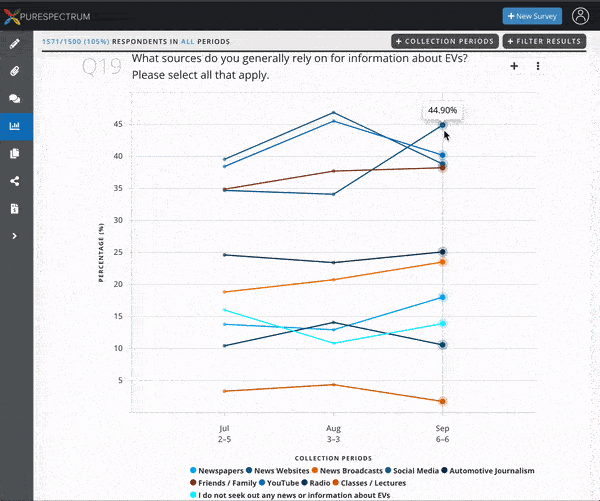
Markets change fast, but consumer sentiments change faster. This is certainly true when it comes to electric vehicles. A year ago, EVs seemed like something everyone was talking about, but few owned. But new brands continue to come to market, and almost every legacy automaker now has an electric offering. In July 2022, CA voted to eliminate the sale of new gas-powered vehicles by 2035, which will undoubtedly affect sales in the state moving forward.
In July 2022, PureSpectrum launched an EV brand tracker to see how consumer sentiments were changing monthly in this fast-growth automotive sector. Our goal was to analyze core KPIs like awareness, purchase intent, and ad recall on how EV brands stack against each other over time. We also studied what was driving or preventing consumers from purchasing EVs.
EV Consumer Motivations
External factors like rising temperatures and gas prices are major contributors to America’s interest in electric vehicles. More than half of survey respondents in our tracker are worried about global warming and believe that higher gas prices are the new normal. We explored America’s opinion of gas price increases in depth earlier this year in our article, America’s Pain at the Pump.
While many consumers watch the EV market closely, only about 15% of those polled own an electric vehicle. When utilizing the PureSpectrum Insights Platform to filter results down further, we found that 19% of men report owning an EV compared to 11% of women.

Source: PureSpectrum Insights Platform
EV Brand Health
Tesla dominates the EV market with the strongest brand awareness, purchase intent, and ad recall. When looking at other exclusively electric brands, Lucid and Rivian trail behind Tesla but are ahead of the rest of the sector on most KPIs.
Source: PureSpectrum Insights Platform
Source: PureSpectrum Insights Platform
Among legacy car brands that make electric vehicles, Ford, Toyota, and Chevrolet generate the highest brand KPIs with American audiences. Audi, Mercedes, and Kia report significantly weaker brand metrics.
Source: PureSpectrum Insights Platform
Roadblocks to Purchasing an EV
Consumers remain unsure if owning an EV is their family’s most cost-efficient automotive choice. Price and gas mileage are the top considerations when purchasing a vehicle, but only 56% of respondents felt that EVs would save them money.
High EV prices and access to charging stations are significant deterrents to purchasing for over half the American population. 68% of respondents are prevented by price, while 55% feel they don’t have adequate charging access. While recent government pushes continue to provide more charging stations nationwide, it seems other campaigns are needed to aid consumer awareness and trust.
RELATED: Warming Up to the Idea of Climate Change
EVs in the Media
Like much of media consumption today, social media and YouTube are the primary sources of information most Americans report using to learn about electric vehicles. The younger a consumer is, the more likely they are to use online platforms for automotive knowledge than legacy publications.

Source: PureSpectrum Insights Platform
To learn more about our EV Brand Tracker, including deeper insights into brand consideration, familiarity, and purchase internet, reach out to our team below.
We will also be reviewing our tracker in our upcoming webinar, 5 Tips to Launch a Brand Tracker Like a Pro, on October 12, 2022.
Methodology
PureSpectrum interviewed 1517 online respondents in three waves between June 30, 2022, and September 06, 2022, using the PureSpectrum Insights Platform. The platform is integrated with the PureSpectrum Marketplace, which combines proprietary measurement tools and third-party data validation to collect high-quality insights quickly. The brand tracker targeted people within the United States and consisted of a general population audience of 18+ years old. This study uses a 95% confidence level to examine the data.
